Here’s why four-wheel drive MF 100 Series models are now very desirable
Posted by Chris Graham on 22nd February 2024
Four-wheel drive versions of Massey Ferguson’s 100 Series models are rare in the UK. Scott Lambert looks at some of these desirable tractors.

This French-built MF 188 features factory-fitted four-wheel drive. (Pic: David Reed)
Massey Ferguson’s 100 Series, the DX line, is the company’s best-loved range of tractors – with the 135 and 165 as the most popular models. It was designed at a time when two-wheel drive was still the norm, and indeed the 500 Series that followed did not have a driven front axle at the heart of its design.
It would be the 1980s, and tractors like the MF 698/698T, 699, and 3000 Series, when Massey Ferguson truly utilised four-wheel drive technology, but four-wheel drive was available for the 100 Series in various forms should you have required the benefits of such a configuration.
In the UK, there were no factory-fitted four-wheel drive models available, but solutions could be found to overcome the problem. Ford buyers, and International Harvester buyers for that matter, had their four-wheel drive needs covered by the likes of County Commercial Cars and Roadless Traction, but these renowned conversion specialists chose not to dabble with Massey Ferguson models.
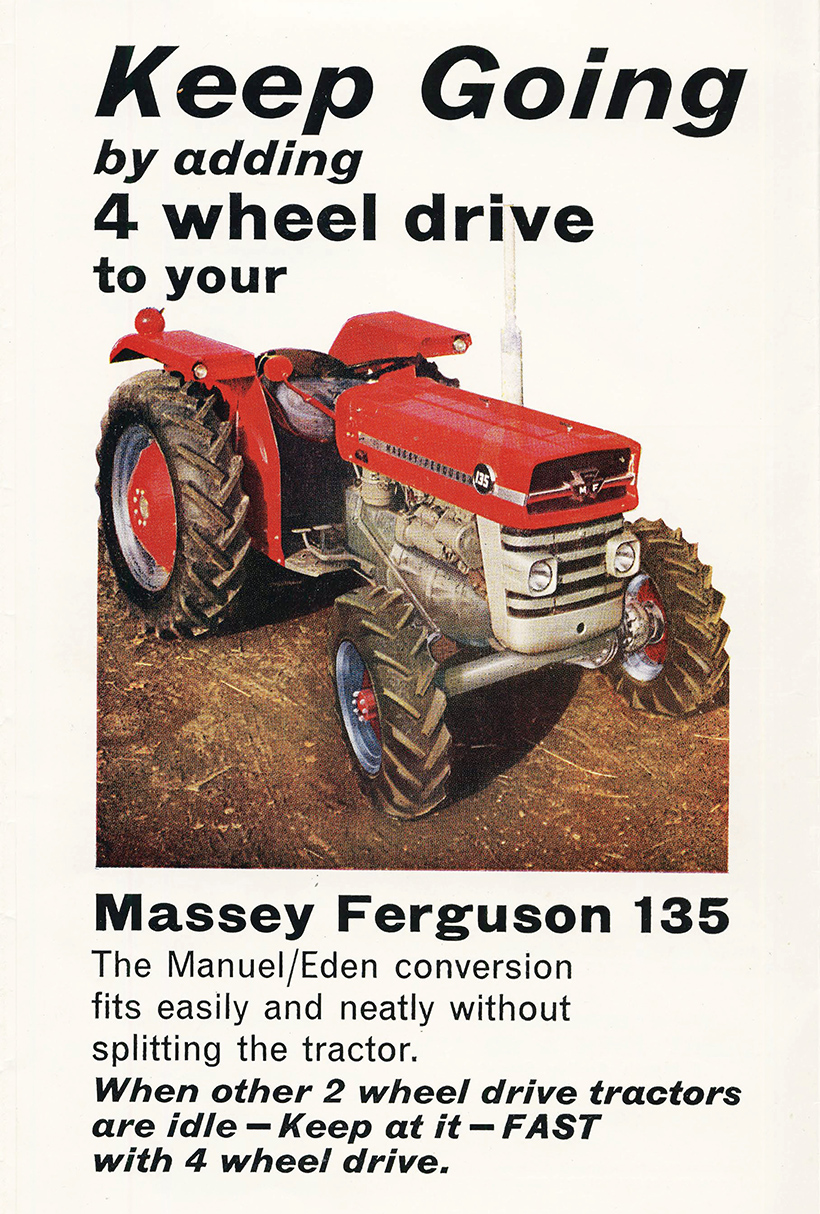
Robert Eden & Co. Ltd. produced conversion kits for the Massey Ferguson 135, 165, and 175.
County did produce high-clearance MF 165s, and may have converted other models similarly, but that’s as far as the relationship went – leaving the door open for other firms to produce four-wheel drive conversions of Massey Ferguson models.
One company that picked up the baton was Robert Eden & Co Ltd of North Audley Street, London. It supplied kits for the MF 135, 165, and 175 (as well as the MF 65 MkI and MkII) that could be fitted on farm, or by the local Massey Ferguson dealer.
The kit comprised a transfer gearbox, that fitted over the power take-off shaft to supply drive to the front axle via ground speed PTO, a lever to engage/disengage drive to the front axle, a propeller shaft with centre support, a torque-limiting clutch (MF 165 and 175), front axle, and wheels. The MF 135 utilised 7.50-20 tyres, while the 165 and 175 featured 9.00-24 and 10.00-24 tyres respectively.
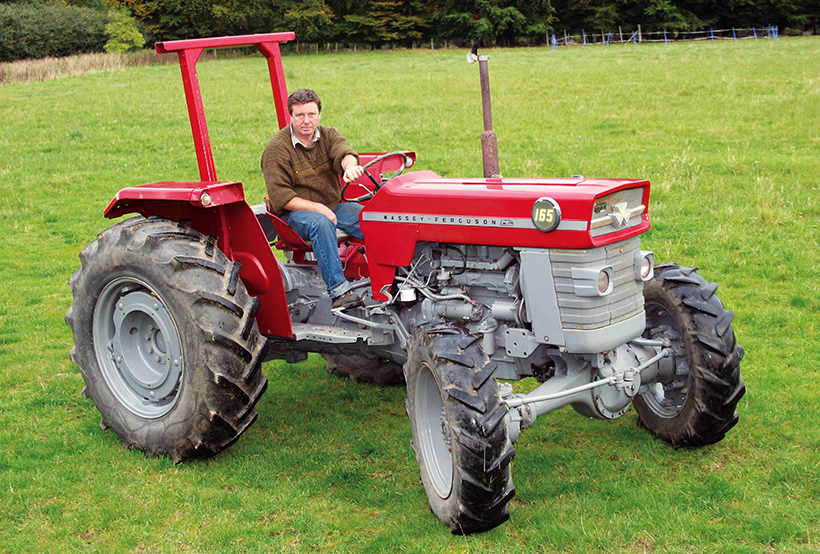
Dave Muirhead’s Massey Ferguson 165 features a Four Wheel Traction conversion. (Pic: Pete Small)
It was a rather crude system, given that drive came from the power take-off, rather than a transfer box between the gearbox and rear axle, but it worked well in arduous conditions – allowing work to continue on the land where it would have otherwise been impossible.
Drawbacks
There were several drawbacks to such a system, meaning that not all jobs could be undertaken as they could with the standard, two-wheel drive tractor. Firstly, as the PTO needed to be in the ground speed position to drive the front axle, it was not possible to use engine speed PTO and four-wheel drive at the same time.
Secondly, the Pressure Control coupler and belt pulley could not be attached, and, lastly, the power take-off shaft was now positioned eight inches (203mm) further back than it was originally. The automatic pick-up hitch could be used, providing an adaptor kit was purchased.
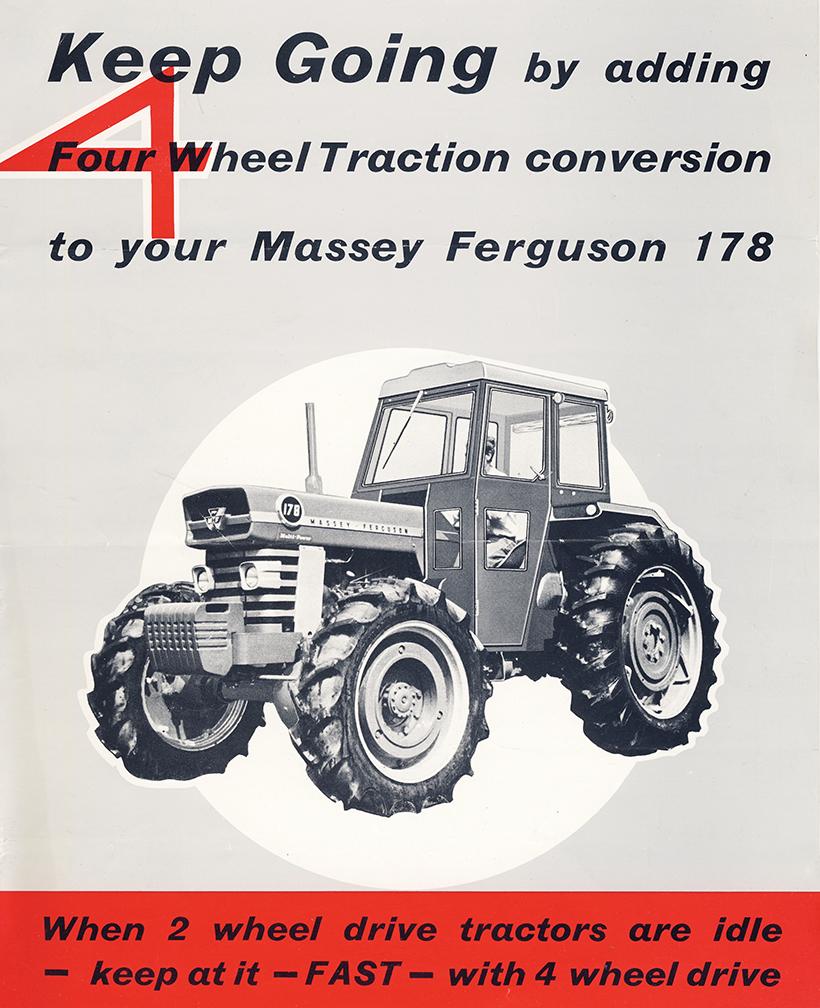
Latterly, Robert Eden & Co. Ltd. became Four Wheel Traction Ltd, and produced kits for various MF models, including the 178.
Such a four-wheel drive conversion kit for the MF 165, for example, weighed in at 1,070lb (485kg), pushing the overall weight of the tractor to 5,134lb (2,329kg) and meaning that 46 per cent of the total mass was now at the front of the tractor, rather than the 40 per cent of the two-wheel drive MF 165.
Robert Eden & Co Ltd subsequently became Four Wheel Traction Ltd, and with it advances were made in the type of four-wheel drive conversion kits available for Massey Ferguson 100 Series tractors.
In addition to the PTO Transfer Gearbox system (PTO type), the Transmission Transfer Gearbox (S type) was made available for fitting to tractors. Drive was taken via a transfer box, between the gearbox and rear axle, via a prop shaft to the front axle.

Featuring a Sekura cab and four-wheel drive system, this MF 135 sold for £31,000 in 2022. (Pic: Cheffins)
Depending on the tractor model, a torque-limiting clutch was either an integral or optional feature of the prop shaft, and a differential lock was also an option for some models.
The transfer box was either six or seven inches long, depending on the model, and either increased the length of the tractor or replaced the existing MF spacer (in the case of the 168, for example).
The beauty of this system is that the PTO was unaffected, and all parts required to replace items affected by lengthening a tractor (pedal linkages and footplates et al) were included in the kit.

Drive for the Four Wheel Traction S type system was taken from a transfer box sandwiched between the transmission and rear axle… (Pic: Pete Small)
Other optional extras included front wheel weights and, to maximise the potential of a four-wheel drive machine, an assistor ram kit for the three-point linkage – increasing capacity from 3,600lb (1,633kg) to 5,300lb (2,404kg) in the case of the MF 168.
French engineering
Such four-wheel drive kits achieved relative success for Four Wheel Traction Ltd., but in France MF took such matters into its own hands – for French farmers and certain export markets. Factory-fitted four-wheel drive options were available for the the four-cylinder tractors, and there was even an MF-marketed 135 Allrad – puportedly aimed at the Alpine region.
Like the kit produced by Four Wheel Traction Ltd, the Massey Ferguson ‘2+2’ four-wheel drive system increased flotation as well as traction – enabling a tractor thus equipped to operate in less favourable conditions when a two-wheel drive tractor might struggle.
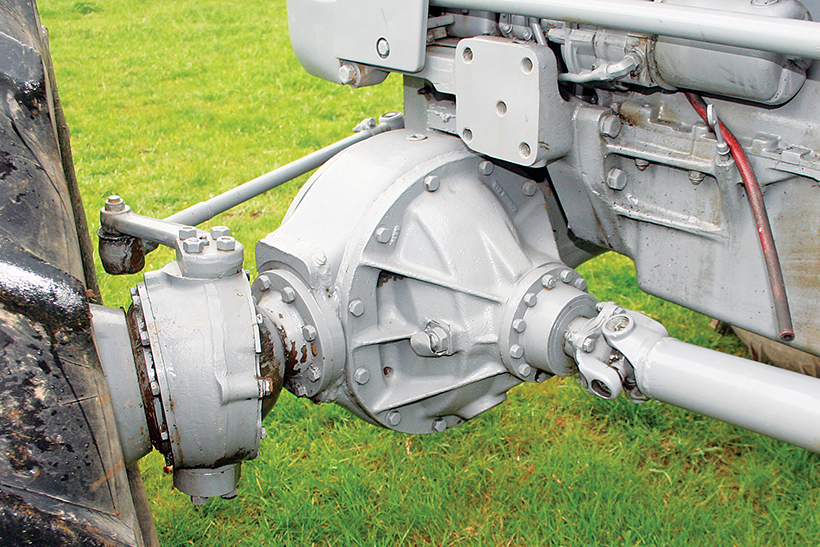
… via a prop shaft on the left-hand side of the tractor, to the front axle. (Pic: Pete Small)
The beauty of a Massey Ferguson four-wheel drive, four-cylinder tractor was, the company said, the fact that the system was MF designed and built, and therefore backed by a full company warranty.
In addition, the design was, it must be said, superior to the Four Wheel Traction system, in that the axle was a centre drive unit, with the prop shaft running fully guarded under the engine sump from the transfer box to the differential.
The front axle incorporated double steering joints, for a tighter turning circle, and epicyclic reduction in the front hubs to reduce torque loading and prevent damage to the tractor’s transmission.
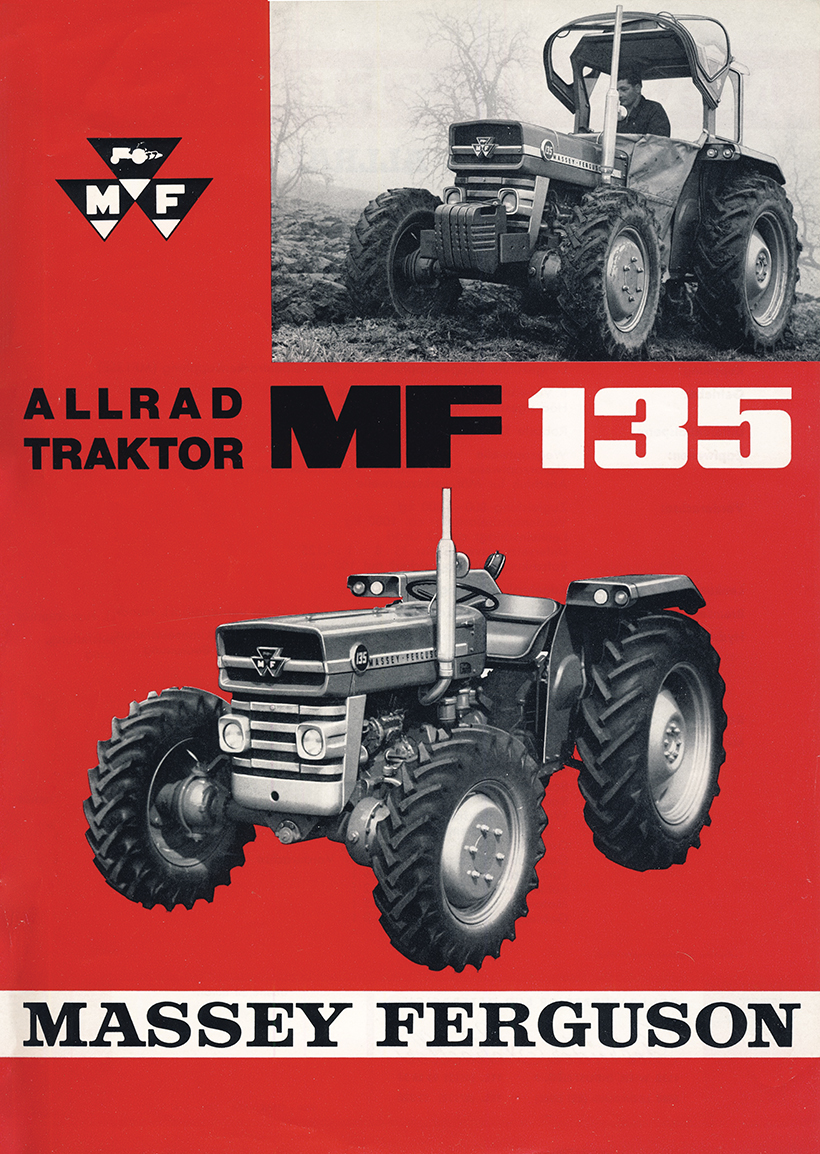
A brochure for the MF-marketed 135 Allrad, complete with 8.00-20 6-ply front tyres.
Inside the transfer box, a multi-plate clutch (incorporating a torque limiter) permitted drive to be engaged or disengaged hydraulically, on the move, to prevent loss of momentum.
Like the Four Wheel Traction arrangement, the addition of the transfer box had the potential to increase the length of a two-wheel drive tractor (depending on the model), but this was not a bad thing.
It moved the centre of gravity further forward, improved access, and provided additional room for the operator once seated.
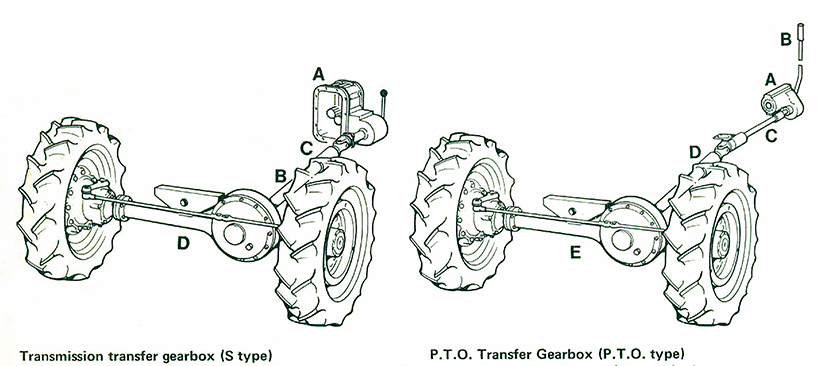
Initially, the PTO-type system (right) was used by Four Wheel Traction Ltd, but this was later bettered by the S type (left).
S type key: A; transfer gearbox, B; propellor shaft incorporating C; torque-limiting clutch, D; front axle with optional differential lock. PTO type key: A; transfer gearbox, B; engagement lever, C; propellor shaft with centre support, D; oil bath torque-limiting clutch, E; front axle with optional differential lock.
Unlike the Robert Eden/Four Wheel Traction systems, where power steering was a recommendation (not fitted as standard on all MF models), Massey Ferguson’s factory-fitted four-wheel drive, four-cylinder tractors featured power-assisted steering as standard – which was a real boon.
Front tyres on the four-cylinder tractors were 24-inch as standard, with 30-inch rears fitted to the 168 and 34-inch to the 188, whereas the 165 MkIII and 178 featured 38-inch rears.
What might have been?
It is this system that ultimately ‘migrated’ to the 500 Series, available in the UK as well as mainland Europe (and certain export markets).
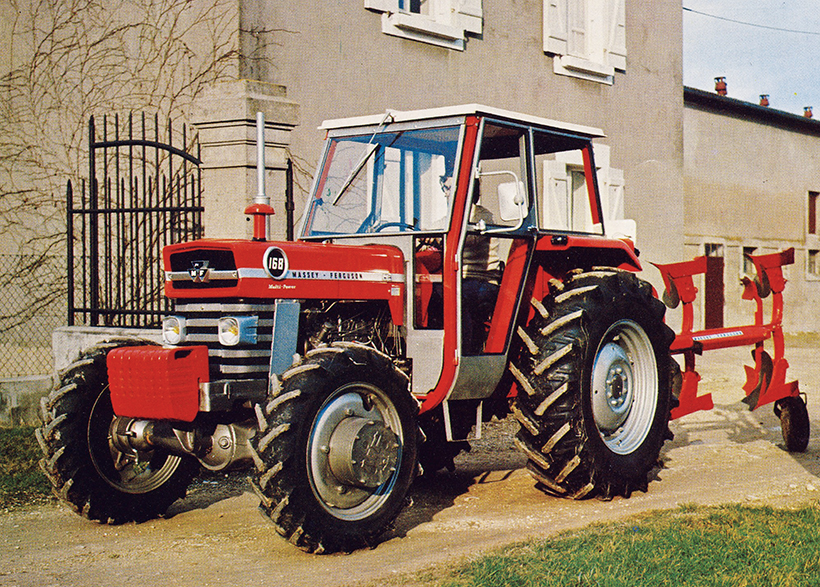
A French-built MF 168 with factory-fitted four-wheel drive.
Given the success enjoyed by Roadless Traction, with its unequal-sized four-wheel drive conversions of Ford and International Harvester tractors, and latterly County Commercial cars – with a similar concept, it seems likely that MF’s four-wheel drive variants would have proved popular had they been offered to British farmers as part of the 100 Series package – either as imported tractors from France, or as a Banner Lane-built option.
The reality is that we will never know how factory-fitted four-wheel drive would have been received for the Massey Ferguson 100 Series in the United Kingdom, but the conversions that appear at auction have commanded high prices in recent years – indicating that enthusiasts find such tractors interesting and worthy of collecting.
In April 2022, a well restored, four-wheel drive MF 135, with Sekura cab (page 30), was sold by Cheffins for an astonishing £31,000, while a four-wheel drive Massey Ferguson 188, in off-farm condition, saw the hammer fall at £11,500 in May 2022.
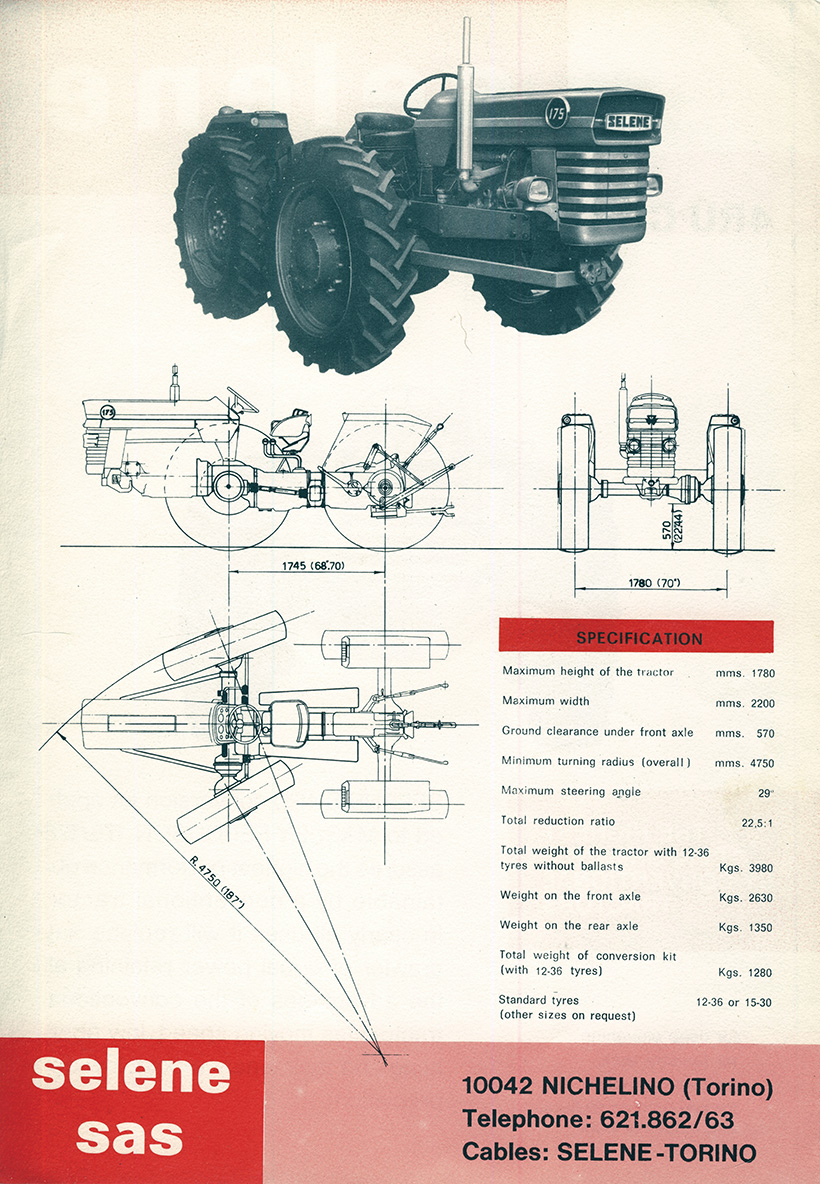
Selene, of Torino, Italy, was famous for its four-wheel drive conversions, but one of its lesser-known kits was the 4RU for the Massey Ferguson 175 and 178. From certain angles it was similar to the conversions produced by County Commercial Cars, but it used a single propshaft to drive the front axle from a transfer box and had a very different configuration to the Ford and IH conversions produced at Fleet. Without an implement attached, 66 per cent of the tractor’s 3,980kg weight was over the front axle, but weight distribution was altered considerably when an implement was put to work. 12-36 or 15-30 tyres were fitted as standard, with other sizes available.
Whether conversions or factory builds, the four-wheel drive variants of Massey Ferguson’s popular 100 Series models make for great talking points at events, and add another dimension to a collection, should you be able to find one to match your budget! ν
* Literature and associated images from the archives of the Massey Ferguson Historian.
This feature comes from a recent issue of Tractor & Machinery, and you can get a money-saving subscription to this magazine simply by clicking HERE

Previous Post
Brilliant Amberley Museum photographic day

Next Post
North Carr Lightship faces an uncertain future



